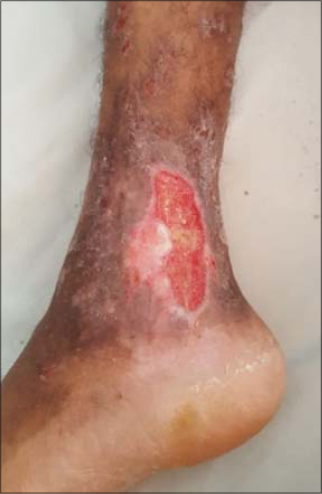Chronic leg ulcer: a complication of sickle cell disease not to be ignored
Nadia Baali , Ouafa Hocar, Said Amal
, Ouafa Hocar, Said Amal
Department of Dermatology, Mohammed VI CHU, Marrakech, Morocco
Corresponding author: Dr. Nadia Baali
Submission: 22.07.2019; Acceptance: 21.10.2019
DOI: 10.7241/ourd.20203.15
Cite this article: Baali N, Hocar O, Amal S. Chronic leg ulcer: a complication of sickle cell disease not to be ignored. Our Dermatol Online. 2020;11(3):300.
Citation tools:
Copyright information
© Our Dermatology Online 2020. No commercial re-use. See rights and permissions. Published by Our Dermatology Online.
The presence of a chronic leg ulcer in a young person is often suggestive of an infectious or traumatic cause. However, it is also a common complication of sickle cell disease and can sometimes be its indication.
We report a case of a 31-year-old hospitalized in our department for a trailing leg ulcer evolving for 6 months and associated with SS sickle cell disease. A dermatological examination showed an ulcer in the right leg, next to the malleolar region, dragging without healing, painful, without a necrosis zone, with irregular and geographical contours. Hemoglobin electrophoresis confirmed the presence of a homozygous SS form. An infectious balance and an ultrasound have eliminated an infectious and vascular cause. A leg ulcer is a dermatological complication rarely reported in homozygous sickle cell disease. It is a consequence of cutaneous pain caused by repeated vaso-occlusive disorders (Fig. 1) [1].
 |
Figure 1: An ulcer in the left perimalleolar region, painful, without a necrosis zone, clean bottom, geographical and irregular contours. |
The presence of trailing malleolar ulcers in a young patient should be suggestive of sickle cell disease and hemoglobin electrophoresis must be conducted. The treatment of leg ulcers in sickle cell disease remains poorly codified. The acceleration of healing rates by the addition of trinitrin during local care has been proven in the series of M. Boustani [2].
Consent
The examination of the patient was conducted according to the Declaration of Helsinki principles.
The authors certify that they have obtained all appropriate patient consent forms. In the form the patient(s) has/have given his/her/their consent for his/her/their images and other clinical information to be reported in the journal. The patients understand that their names and initials will not be published and due efforts will be made to conceal their identity, but anonymity cannot be guaranteed.
REFERENCES
1. Ndiayea M, Niang S.O, Diop A, Diallo M, Diaz K, Ly F, et al. Leg ulcers in sicklecelldisease:A retrospectivestudy of 40 cases. Mémoire originale. Ann Dermatol Vénéréol. 2016;143:103-7.
2. Boustani M, Roignant C, Kuk B, De Luna A, Habibi E, Fois E, et al. Traitement des ulcères de jambe drépanocytaires par la trinitrine. Rev Méd Inter. 2018;39:A118–A252.
Notes
Source of Support: Nil,
Conflict of Interest: None declared.
Request permissions
If you wish to reuse any or all of this article please use the e-mail (brzezoo77@yahoo.com) to contact with publisher.
| Related Articles | Search Authors in |
|
|



Comments are closed.